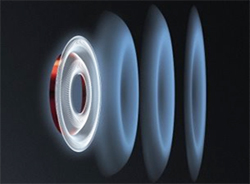You heard it here first…
A couple of years ago at the ULTRA Festival in Miami, I did single-ended measurements of various EDM (electronic dance music) genres using SysTune from AFMG. I merely set the averaging to infinite, put the analyzer in RTA mode, and let it run for hours, sampling internet streams of trance, house, bass music (drum and bass and dubstep), etc.
One thing that’s clear is that there are two frequency bands that dominate the bass region: 50 to 60 Hz is the norm for trance and techno, while mid to high 40 Hz dominates dubstep (for sure) and probably drum and bass. It’s not “all” in these specific regions, but a great deal is.
My theory (and it’s just that, nothing “proven”) is that 50 Hz has been traditionally chosen because of practical low-frequency limits of common subwoofers in the past. They will all do 50 Hz (hopefully), and anything below that would be considered gravy.
So to get max “oomph” out of the average system DJs use (and presumably home hi-fi systems as well), the bass was focused in an area in which solid reproduction could be guaranteed.
This goes for car systems as well. I think we’re all familiar with the “one note trunk rattler.” I believe it’s a fairly simple matter to design a car subwoofer that reproduces one note really well, and leave it to the reader to speculate what that note may be…
But times are a-changin’, with 40 Hz common, 30 Hz now possible, and in some cases, usable sub-30 Hz performance is available (but still fairly rare). Please don’t confuse what I’m saying with published specs from manufacturers. What I heard this year at ULTRA confirms this. There were three systems there that could do 30 Hz, and two for sure that were only a few dB down below that.
1.db audiotechnik J-INFRA. Prodigious LF output down to 30 Hz, and according to my measurements, two years ago, about -4 dB at 26 Hz. It definitely delivers the goods. Beachsound used a different setup, with J subs stacked on top of INFRAs, and it solved the problem of high bass being lost in the crowd when the Js are on the ground. (Nice job, Beachsound.)
2. JBL VTX. I didn’t measure this system, but Raul Gonzalez was the tech and he had it sounding great when I arrived, so we just listened. The midrange was very clear to my ear, and nothing hurt when pushing test tracks. The G28 subs had a lot of extension and the grunt to go with it. It really came alive when Raul put a + 3 dB filter in at 26 Hz. Very solid subbass sound. I liked it.
3. BASSMAXX ZV28. David Lee has been working on this design for several years and has improved every iteration. He used 16 of these beasts on the UMF Worldwide Stage (the “street party” stage), with some upper bass boxes on top. We could hear things in tracks that would have not been present with “normal” subs, meaning usable response only down to the mid 40 Hz region.
This sub would blur your vision and modulate your voice, no problem. I’ve been told this is the weakest of the dual-18 line, with lower power drivers, so I’m keen to hear the high-power version. This thing is sick.
I took a SysTune measurement of this sub array that’s shown in Figure 1. (By the way, the measurement mic is a Josephson C550H.)
So, the low frequency extension is available. We’ll see who actually leverages it in the future.
And a note to DJs: please make better sounding tracks. We can hear the difference between MP3 and .wav on these systems. Your audience deserves better.
Based in the St. Louis area, Doug Fowler has worked in professional audio for more than 30 years and is a moderator of the ProSoundWeb LAB forums, where this article originated.
















